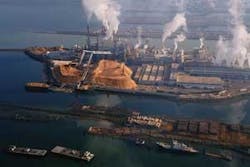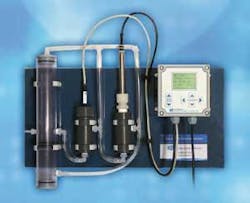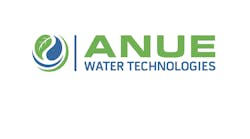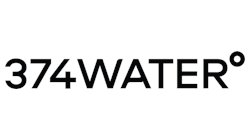By Steve Rupert
Chlorine is commonly used in many industries as a bleaching and oxidizing agent. These include the chemical processing, pharmaceutical, textile, and pulp & paper industries. It’s used as a disinfectant or sanitizer in the food & beverage processing industry, as well as by municipal water plants to control odors and improve the taste of drinking water and eliminate pathogens at wastewater treatment plants.
Cooling towers at petrochemical refineries, power plants and the HVAC systems of most large buildings use chlorine to control the growth of microorganisms, algae and biofilms in the cooling water. These microorganisms and biofilms reduce the efficiency of the cooling tower and may facilitate the spread of illness like Legionnaire’s Disease.
What is free chlorine?
Chlorine gas and/or sodium hypochlorite (bleach) are the common sources of chlorine in water. Both types form the same compounds when introduced to water: hypochlorous acid, HOCl, and hypochlorite, OCl-. The percentage of each component in solution is dictated by the pH of the solution. At roughly a pH level of 7.5, the ratio is 1:1. If the pH drops to 6.5, then the acid form is favored with 90% HOCL and 10% OCl-. At a pH level of 8.5, the alkaline form predominates as 90% OCl- and 10% HOCl. Hypochlorous acid has roughly 10X the oxidizing power of hypochlorite. These two types of chlorine are referred to as free chlorine.
Other chlorine compounds may be present in the treated water as well, with organically bound chlorine and chloramine being the most common. These compounds are referred to as combined chlorine.
Why is it measured?
Chlorine is used primarily as a disinfectant or sanitizer; and, for best results, the levels must be monitored online, typically with a chlorine sensor. The chlorine is consumed as it disinfects, which is referred to as chlorine demand. To maintain the disinfection a residual is needed. As such, dose minus demand equals residual.
Free residual chlorine must be measured and controlled because it’s an important aspect of keeping maintenance costs in line. The key to successful use of chlorine is in maintaining the right concentration. A chlorine concentration that’s too high injects unnecessary costs into a process. Overly low levels of chlorine mean you aren’t accomplishing the disinfection or other process goal and your process is ineffective.
Feedback in real time is critical with regard to how closely your process is maintaining the optimum levels of chlorination you’ve established. Concentration control of free chlorine at optimum levels means effective dosing occurs with no spikes or valleys that result when manual testing is performed. Additional benefits of online chlorine monitoring include:
- Lower chlorine usage; it’s an expensive chemical to source given the major amount of energy required to produce chlorine
- Reduced maintenance needs by ensuring your process adheres to best practices
- Good environmental stewardship
How is it measured?
Industrial process engineers need free chlorine analyzer systems that measure precisely and are cost effective to install and maintain. The two major types of instruments for the measurement of free chlorine are colorimetric tests and amperometric analyzers.
There are two types of colorimetric tests. The manual test method is similar to a swimming pool test. The automated colorimetric test requires a sample system and reagents. Colorimetric tests are EPA approved for reporting purposes, but they are not real time measurements that are the best suited for accurate process control.
Amperometric analyzers, such as those manufactured by ECD and others feature a rugged chlorine sensor that is automatically compensated for pH. There are multiple manufacturers of amperometric analyzers with many different other models as well.
For example, the ECD Model FCA-22 analyzer provides online continuous free chlorine measurement in a systems package. It monitors free chlorine from 0.05-20.0 ppm Cl2, at 5-9 pH and at temperatures from 32-122°F (0-50°C). The sensor’s polarographic gold/silver PFTE membrane construction extends life to reduce maintenance costs. A multi-bus controller design enables easy customization of outputs and control functions. It has two SPDT relays and a 4 to 20 mA output for the free chlorine signal.
What are measurement challenges?
Food Processing/Pasteurization Lines – Chlorine is commonly used as the sanitizing agent for rinsing fruits and vegetables before processing. It’s also used in the rinse water at poultry and meat processing plants. Maintaining the proper chlorine residual in the recirculation tanks optimizes sanitizing power of rinse water and minimizes possibility of contamination, thereby conserving water.
Canned and bottled foods are typically pasteurized by passing through a hot water rinse or bath at the end of the packaging process. Recirculated water quickly accumulates products from the canning or bottling process, so a chlorine residual is maintained to sanitize this nutrient rich broth.
Municipal Drinking Water – Drinking water comes from many sources, lakes, rivers and groundwater wells. This water is dosed with chlorine in a primary disinfection; it’s then filtered to improve clarity and then chlorinated again in the secondary disinfection step. A chlorine residual is maintained in each of these chlorination steps. The secondary disinfection ensures disinfection of the water and provides a chlorine residual intended to maintain the sanitized water throughout the distribution system.
Cooling Towers – In the refining of oil/gas products and specialty chemicals, the raw crude is typically heated at high temperatures in the separation process. In power plants, steam is generated to drive generators and in both cases large heat exchangers are cooled with water via cooling towers. Various chemicals, including free chlorine, are introduced into the water to prevent the growth of algae and biofilms that are a continuous maintenance problem.
Conclusion
The accurate measurement of free chlorine is essential to maintaining our high standard of living. It contributes to the sanitation in food and drinking water and the disinfection of waste water along with many other industrial processes. When selecting a measurement method and an instrument, it is important to consider not only the instrument’s measurement accuracy, but also the ease of installation and use, the required maintenance, the service life of the instrument and the total ownership cost.
About the Author: Steve Rupert is senior product manager at Electro-Chemical Devices (ECD) Inc., a specialist in industrial process instrumentation – sensors, controllers, transmitters, analyzers and electrodes – based in Yorba Linda, CA. Contact: 800-729-1333 or www.ecdi.com




